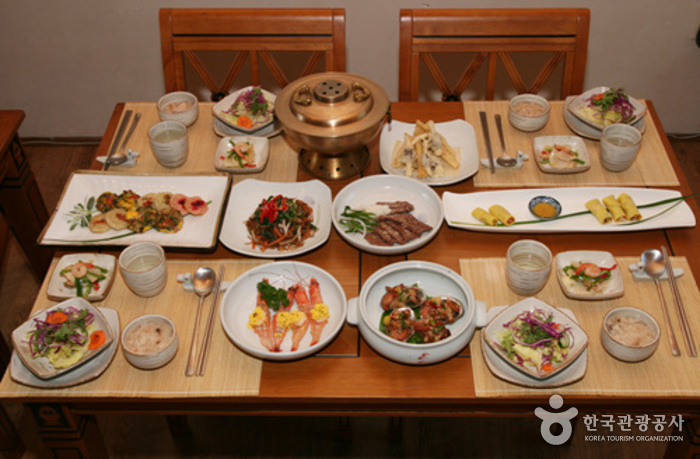Jogeummaru (조금마루)
16.9Km 2024-02-20
9 Seosangpyeonggangbyeon-gil, Samnam-eup, Ulju-gun, Ulsan
Jogeummaru is a duck specialty restaurant that exclusively utilizes domestically-raised ducks in its culinary creations. The ducks are raised with sulfur, contributing to a clean and rich flavor profile, free from undesirable odors. The signature menu features ori yangnyeom bulgogi (duck bulgogi), ori tang (duck soup), and ori sutbul gui (charcoal-grilled duck). Ori yangnyeom bulgogi entails duck marinated in a spicy seasoning, grilled on a pan with added chives. Ori tang is a meticulously prepared broth cooked for 12 hours, incorporating various vegetables. Additionally, eomnamu ori baeksuk (whole duck soup with castor aralia) offers a unique dish where duck is boiled with medicinal herbs.
Wondongmyeon Minari Festival (원동면 미나리 축제)
17.1Km 2025-02-06
Yongdang-ri, Wondong-myeon, Yangsan-si, Gyeongsangnam-do
+82-55-382-5502
The Wondongmyeon Minari Festival celebrates the sulfur vitamin parsley, a local specialty of Wondong-myeon in Gyeongsangnam-do. A Minari (parsley) Town will be established after the festival to regulate the quality and price of parsley.
Dodong Sanbang (도동산방)
17.1Km 2019-02-12
133, Songnakgol-gil, Ulju-gun, Ulsan
82-52-254-7076
Dodong Sanbang is a restaurant with five separate traditional Korean buildings situated on a large plot of land. It serves great traditional Korean set meals, and has a separate tea room where customers can enjoy a cup of tea after dining. Excluding winter, the restaurant offers a special program called “tteok mechigi” (rice cake pounding) where customers are invited to pound (or make) a rice cake with a mallet and eat it. The restaurant also includes a traditional souvenir shop and rice cake shop, and offers cultural programs.
Eonyang Jinmi Bulgogi (언양진미불고기)
17.2Km 2024-02-20
33 Jungpyeong-ro, Samnam-eup, Ulju-gun, Ulsan
Eonyang Jinmi Bulgogi specializes in using Korean beef to create tender and flavorful Jinmi Bulgogi, where the natural taste of the ingredients is preserved. The signature dish features fresh beef topped with plenty of minced garlic, grilled to perfection over charcoal. The rich and well-presented side dishes, including yukhoe (beef tartare), complement the main dish and enhance the overall dining experience. The unique aspect of Eonyang Jinmi Bulgogi is the enjoyment of the dish without broth, grilling the meat on the grid and savoring it with green onion threads.
Homeplus - Miryang Branch [Tax Refund Shop] (홈플러스 밀양)
17.4Km 2024-04-18
45, Jeompiljae-ro, Miryang-si, Gyeongsangnam-do
-
Eonyang Giwajip Bulgogi (언양기와집불고기)
17.6Km 2025-03-28
86 Heonnyang-gil, Eonyang-eup, Ulju-gun, Ulsan
* Please be advised that this is located in one of the areas affected by the recent wildfire (as of March 27, 2025).
** For real-time wildfire information and emergency upates, visit the Korea Forestfire Information website and the National Disaster and Safety Portal.
Eonyang Giwajip Bulgogi is a more than 40-year-old establishment housed in a renovated hanok with a history exceeding 100 years. Eonyang bulgogi is crafted by finely mincing beef, seasoning it with various spices, and grilling it on charcoal until it becomes wide and flat. The use of a gridiron for grilling imparts a distinct smoky flavor, and the mild seasoning contributes to a pleasant texture. When wrapped in fresh vegetables alongside pajeori (green onions), the combination produces an outstanding taste. The doenjang jjigae (soybean paste jjigae) and side dishes, known for their subtle seasoning, offer a clean and refreshing taste.
Naewonsa Temple (Yangsan) (내원사(양산))
19.0Km 2024-02-23
207 Naewon-ro, Habuk-myeon, Yangsan-si, Gyeongsangnam-do
Naewonsa Temple, situated in Cheonseongsan National Park, is home to a monumental Buddha statue standing at 5.5 meters, crafted during the Silla dynasty. The temple complex features various structures, including Bogwangjeon and Geungnakjeon Halls, showcasing its captivating architectural style. Renowned for its picturesque mountain landscapes and as a popular destination for autumn foliage, the temple attracts numerous visitors every year.
Naewonsagyegok Valley (내원사계곡)
19.1Km 2021-02-18
207, Naewon-ro, Yangsan-si, Gyeongsangnam-do
+82-55-380-4826
Naewonsagyegok Valley is located just below Naewonsa Temple at the foot of Cheonseongsan Mountain. The valley is surrounded by Jeongjoksan Mountain to the northeast, Wonjeoksan Mountain to the south, and Cheonseongsan Mountain to the southeast. The water running through the numerous valleys between these mountains has formed streams like Yongyeoncheon and Sangnicheon, which form the Yangsancheon Stream out of Naewonsagyegok Valley.
Naewonsagyegok Valley was formerly called Sogeumgang (little Geumgang), meaning that its beautiful scenery is comparable to that of the breathtaking Geumgangsan Mountain. It is also known as the “mystical valley” as crystal clear water flows all year round. The word “Sogeumgang” is distinctly engraved on one side of the cliff and large rocks stand in layers throughout the valley. Some of the rocks are called Byeongpungbawi Rock, literally meaning folding screen rocks, as they are stretched out much like folding screens.
The valley and the surrounding mountains are a popular summer vacation spot and a well-known hiking destination during the spring, fall, and winter. Muk (acorn jelly) made with acorns gathered from this area not only tastes great, but is also very healthy. Nearby attractions include Tongdosa Temple and Hongnyongpokpo Falls.
* Entrance into the upper region of Naewonsagyegok Valley is restricted.



![Homeplus - Miryang Branch [Tax Refund Shop] (홈플러스 밀양)](http://tong.visitkorea.or.kr/cms/resource/26/2885926_image2_1.jpg)

 English
English
 한국어
한국어 日本語
日本語 中文(简体)
中文(简体) Deutsch
Deutsch Français
Français Español
Español Русский
Русский